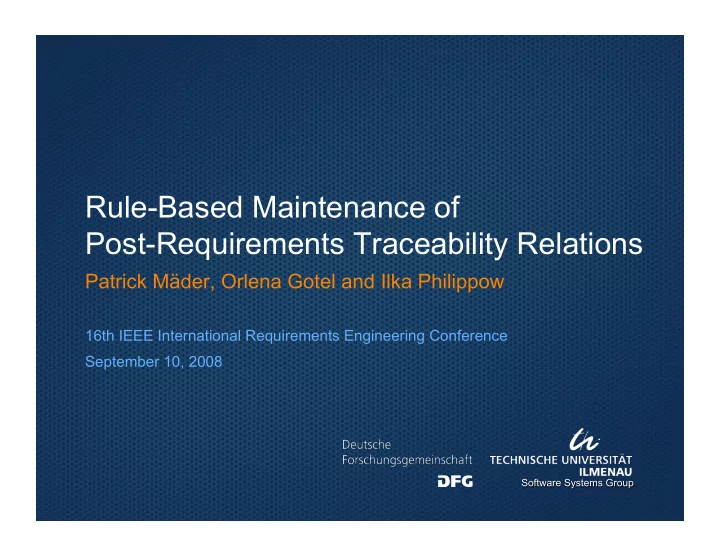

Rule-Based Maintenance of Post-Requirements Traceability Relations Patrick Mäder, Orlena Gotel and Ilka Philippow 16th IEEE International Requirements Engineering Conference September 10, 2008
� Requirements traceability � Our approach � Traceability maintenance rules � Prototype and preliminary validation � Conclusion and future work 2
� Traceability of development processes � Allows to follow the development process and relates the intermediate products Each traceability relation represents an activity � Requirements traceability supports � Analyzing the impact of changing requirements � Verifying the implementation of requirements � Program comprehension � Supporting regression test � Reuse … 3
� Problems � Necessity to manually create and update relations (Large numbers of relations even for small systems) � Accurate set required for comprehensive results � Insufficient method and tool support � Focus � Maintenance of traceability relations during evolution and refinement of structural UML models 4
� Requirements traceability � Our approach � Traceability maintenance rules � Prototype and preliminary validation � Conclusion and future work 5
� Approach to tackle the problem of traceability decay due to evolution of related model elements � Stage 1: Capturing changes to model elements and generating elementary change events � Stage 2: Recognizing the wider development activity applied to the model element, as comprised several elementary change events � Stage 3: Updating the traceability relations associated with the changed model element 6
� Example: Convert attribute to a class 7
� Main challenges � Relate several elementary change events to one activity � Recognize different orders of the same events as one activity � Recognize different sequences of events as the same activity 8
� Requirements traceability � Our approach � Traceability maintenance rules � Prototype and preliminary validation � Conclusion and future work 9
� Traceability maintenance rules � Patterns of change activities that require traceability updates and directions to perform it � Stored as XML rule-set � Status � 21 rules capturing 37 development activities � Supported elements: associations, inheritance, attributes, methods, classes, components, and packages 10
� Rule application process 11
� Limitations � Only predefined activities can be recognized � Current rule-set is reusable and stable, but unlikely to reflect all possible activities – need for customization likely � Support for rule definition? � Rule editor and validator available 12
� Requirements traceability � Our approach � Traceability maintenance rules � Prototype and preliminary validation � Conclusion and future work 13
� traceMaintainer � Prototype implementation to be able to validate the approach � Tool-independent rule engine and link maintainer � Special adapter per CASE tool necessary, available for Sparx Enterprise Architect, ARTiSAN Studio, and ToolNET 14
� Two experiments using traceMaintainer to explore the following research questions 1. Is it capable of maintaining links at a level of accuracy comparable to manual maintenance? 2. How much manual effort can be saved by using automated maintenance in relation to the kind of modeling undertaken? 15
� Experiment � Two developers spent three hours on two sample projects respectively � Analysis of correctness and completeness after refining an analysis model into the design model � Results � Result: 94–97% precision, 93–98% recall between manual and automatically maintained set of traceability relations Manual trace Changes Activities Modeling Maintainer Saved maintenance Optimistic 127 35 64,5 min 62,0 min 18,2 min 71% execution Pessimistic 176 49 82,2 min 115,8 min 18,2 min 84% execution 16
� Requirements traceability � Our approach � Traceability maintenance rules � Prototype and preliminary validation � Conclusion and future work 17
� Conclusion � Approach supports the automatic maintenance of traceability relations � Preliminary results show the approach capable of reducing the effort in maintaining traceability quite dramatically and at a high level of precision � Future work � Semi-automatically creation of new rules (rule recorder) � Further integration into the development process � Additional actions after activity recognition 18
Thank you. Patrick Mäder Software Systems Group
Recommend
More recommend